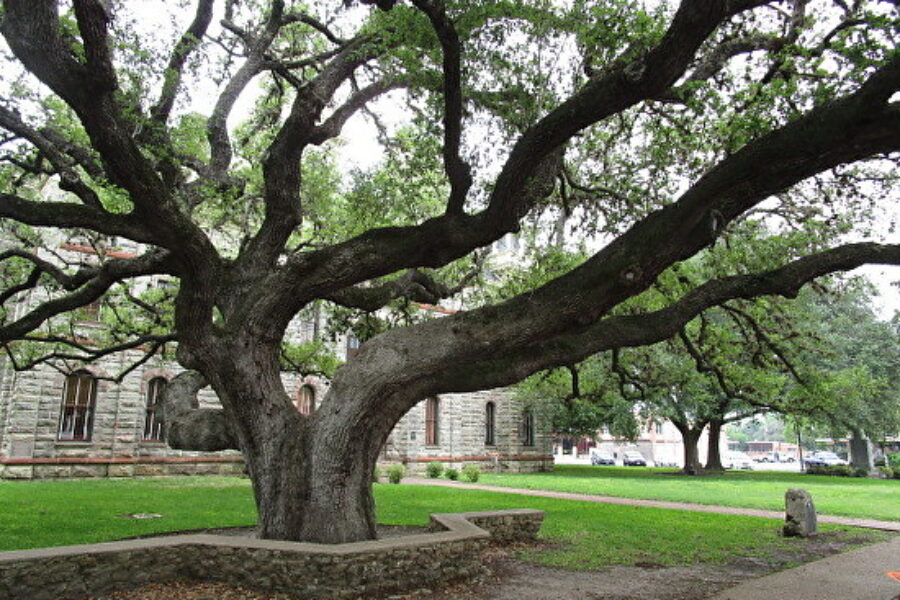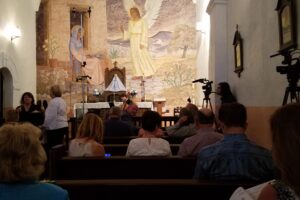Leaving San Marcos and sailing through the flatlands on our way to the coastal plains I realize how different the Texas Hill country really is—five minutes away and I miss it already.
We fly through Geronimo and try not to blink. It has been years since we drove past this tiny town and it looks like the residents are trying to climb on the tourist wagon. They are working hard on cute; not yet achieved, but they are trying.
Monitoring our progress I glance at the GPS APP on my phone. Timing is everything and I think mine might be just a bit off. I suggested a trip to Goliad, and a tour of the missions thinking it was just a few miles down the road. Now Google maps tells me our destination is two hours away.
I look at Michael, “I don’t want to appear always to be thinking of food, but if we want to eat today, we have to have lunch as soon as we get to Goliad.”
I feel the need to explain as I get the look. “Honestly, all of the restaurants close at 2 p.m. Unless you want to eat at Dairy Queen.”
Lunch at the Empresario
We pull into the quaint small town a little after 11:30. A woman stands before the courthouse snapping a picture. We look for the Empresario—it is one of the few restaurants open for lunch today and according to Trip Advisor it is one of the best. Parking our car in front of the courthouse, we cross the street and enter the sparsely populated space. Greeted immediately by the wait staff we are shown to a booth and handed a menu.


I want to be good (i.e., healthy) and order seafood, because we are halfway close to the coast. However, I change my mind and decide on a BLT sandwich instead. Empresario bacon is two dollars extra. The waiter explains it is house-smoked and cut extra thick and convinces me it is worth the extra two hundred pennies. Then Michael tells me a fried egg can be added for another dollar, and avocado for just a little more.
I sit here envisioning a Dagwood sized sandwich with a zillion calories, and then I remember the best hamburger I ever ate during a road trip in Spain last year—fried egg and all. When the waiter assures me I will be able to open my mouth wide enough to take a bite, I tell him to give me the works. And iced tea. Then I discover another menu. When the waiter returns I order a glass of wine.

Of course I can’t eat the whole thing. Michael deconstructs the remaining half sandwich and eats what he considers the good parts.
The Courthouse Square
Before heading for the missions, a walk around town is a must. Goliad has achieved cute—maybe it was always cute. Tuesdays are quiet around here and we have the entire town square to ourselves as we drift aimlessly from shops to courthouse grounds and back again.


A massive tree in the center of town confronts me; I think—that’s big enough and the limbs are long enough for it to be a hanging tree. I read the historical marker beside its gargantuan trunk—hanging tree, right on the courthouse lawn for immediate dispatch of the convicted. I’m having a hard time imagining the reality of a public hanging.


I round a corner and see another stone marker, discovering how Goliad got its name—an anagram of Hidalgo—minus the H—from Father Miguel Hidalgo y Costilla, the leader of Mexico’s fight for independence from Spain. It feels like I have stumbled on an old friend, having visited the house where he lived in Mexico. I have been to his church and followed his footsteps. I am glad that he is not a stranger to me.
Exploring the Missions
We leave the town center—taking a detour or two and then head for the first of our mission stops. I think how good it is to have the time to be flexible as we walk back to our car after seeing a busload of school children hike up the hill to the entrance of Mission Nuestra Señora del Espíritu Santo de Zúñiga. Since there are two historic missions in this town we silently agree to turn our bodies and our car around, nosing down the short path and across the highway to Presidio La Bahía. And I’m confused.

Having traversed the road to and through Goliad at least a dozen or more times since I was a child, and visited one or both of these structures I always saw two churches and always thought—two missions. Today I discover I am wrong, about so many things.

Presidio La Bahía
Owned by the Victoria Diocese of the Catholic Church, I find that now—at this moment, and always—it is and was a fort. However, it does have a church. It looks like a mission. I must have never read the signs or talked to the guides. I recall the layout of San Jose in San Antonio and feel a tiny bit better about my misconception.
Founded by the Spanish in 1721, it was moved to its current location in 1771, captured by Mexican insurgents during the Mexican War of Independence, regained control of by the Spanish, relinquished again to the Mexicans, taken over by Texans during the Texas Revolution—renamed Fort Defiance—only to be taken back by the Mexicans and back again by the Texans. The French were in there somewhere too—as a defense against, not a captor—and now here we are. And here I am. Informed.


Connections
There are so many connections. I think of our trips to Spain and King Carlos II, and Napoleon’s march to take over Europe—the main reason behind the Mexican revolt against Spain. They did not believe in bowing before and reporting to Joseph Bonaparte. And I think of the massive paintings in Amsterdam depicting Napoleon’s greedy need for power, and Michael’s ancestor, the hero who fought the Mexican’s during the revolution and was imprisoned. And all of the death and dying and bullets and deprivation, and finding out that Fannin was possibly the ultimate example of The Peter Principle, causing even more needless death.
I’m exhausted just thinking about it all and trying to keep things straight.
We explore the rooms within the walled fort, watch a short film on its history and traverse the barren ground within the surrounding walls—dodging a myriad of tiny ant hills as we go. Mostly I look down—not up and around. In sandal shod feet I have gone from potential victim…to bitten.
It is hard for me to envision what was—the battles—the terror that must have been felt by many that inhabited this place. I only see the cloudy skies and endless peace. The shade of the trees. The rough stone walls. The squat grasses interspersed with the ever-spreading flowering green weeds…and ants.

I stop at the reception desk on the way out to purchase a book, Surrender and Infamy; I feel a great need to know the rest of the story.

Mission La Bahia
We cross the highway back to the state park and Mission Nuestra Señora del Espíritu Santo de Zúñiga, also known as Mission La Bahia. The children are gone, and I am in for further surprises. The mission like the presidio was transitory. It was not so much a thing but a community. Depending on circumstances, it either stayed where founded or moved from place to place. And the two historic structures are connected.
The presidio existing to protect the mission; the mission existing to get all of Spain’s holdings on the same page—religiously speaking. It seems Spain’s civil and religious activities were combined, and the missions here in Texas were controlled by Franciscan conventos in Central Mexico; one in Queretaro. I’ve been there. This makes me smile. I can relate.
La Bahia History
Established by the Spaniards in 1722 on the shore of Matagorda Bay to convert local Indian tribes to Christianity, the mission was moved four years later to the vicinity of Victoria. Less than a quarter-century later it was moved to its current home where it became the first large cattle ranch in Texas. There were 40,000 head of Longhorns and Mustangs, cared for by the newly Christianized Indians.
Apparently these new world missions were a financial drain on Spain and the intent was to always hand them over to local religious authorities. Five years before the Texas revolution began, the mission was secularized. It was rebuilt by the CCC from the rubble that remained after its secularization and abandonment. Today the state of Texas owns it; only fragments of the fiercely protected original stone walls remain.





The Building
Today It is white. It is pristine in its whiteness. Passing it on the highway in years past I remember drab gray stone.
“When did you paint it?” I ask a passing ranger.
“It’s always been white.”
Another ranger corrects the statement, “About twelve years ago.”
I stare up at the old church and its whiteness—the way it was when originally built by the Franciscans almost two centuries ago. I can see Southern Spain in its non-color and design, remembering the sugar cube stacked towns of southern Spain. A legacy left and lesson learned from the Moors that invaded their shores—white reflecting the brilliance of the sun—rooms within remaining cool in the oppressive heat. Spain, it invades my senses; its history and struggle and beauty and similarities to Texas. Our connection to it. Its connection to us.


Back home I head to one of our many bookshelves and take down the tome that is James Michener’s, Iberia (his personal travelogue of a land he loved), and begin to scan its almost fifty-year-old pages. I look for the line where he compares Texans to Catalans in their fierce pride of place in the land of their birth. Not easily found, I settle in, starting at the beginning.

5/8/2016 10:42:29 PM







Leave a Reply
Your email is safe with us.